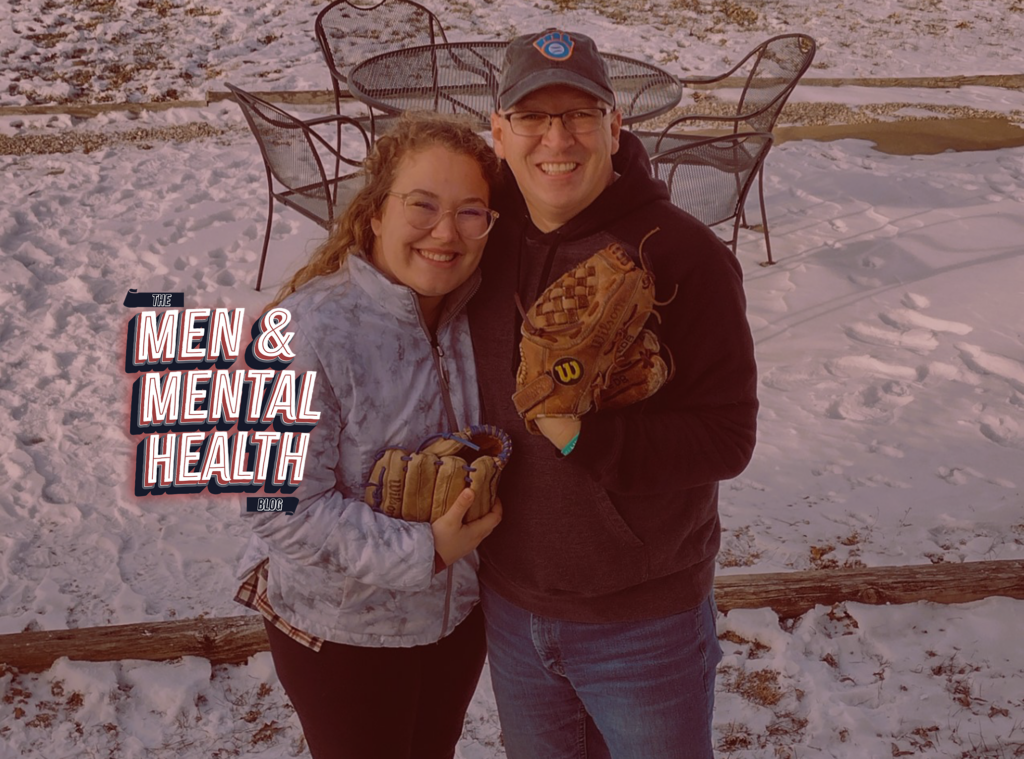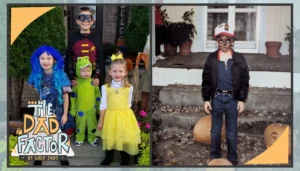My baseball career ended at the age of 16, as a junior varsity benchwarmer. I couldn’t throw as hard or run as fast as my teammates. But, that is still longer than most kids play these days. Now, by age 14, more than 70% of ballplayers have stopped playing ball. David Ogden is a researcher at the University of Nebraska. Of the steep decline in kids playing baseball near the age of 14, he wrote, “We are looking at a generation who didn’t play catch with their dads.”
I am a dad. Kaylea is my oldest daughter, a long-haired, curly-headed violinist who loves a good pun. She plays in the symphony orchestra at Missouri State University.
My youngest daughter Sophie is an artist. Her ability to see something and then recreate it with watercolors or pencil sketches or acrylics truly astonishes me.
For Christmas 2017, a 13-year-old Sophie gave me a simple gift, a baseball. On the baseball, carefully handwritten, were the words, “Dad, wanna play catch?”
On New Year’s Day of 2018, battling the post-holiday blues, I played catch with both of my daughters.
That night, as my family sat at the dinner table, talking about all the things you talk about on the first day of the year, my daughters asked me, “Dad, what would happen if you played catch every day for a whole year?”
I laughed and replied, “What would happen if I played catch for a whole year? I would need surgery.” I have had multiple major surgeries and can show you some cool scars upon request. I did not have any desire whatsoever to add any more scars to my collection.
Even so, my daughters encouraged me and challenged me to consider it.
In 2018, I played catch every single day for an entire year. My friend Aaron called the whimsical effort Catch 365. That year has continued to teach me so much about what it means to live a good story.
We live in a culture that is play-deprived, depressed, lonely, distrustful, and always distracted.
A 2019 study conducted by child development experts discovered that “More than 75% of children under 12 are not getting enough free, active, playtime.” The older we get, the less we tend to play.
Dr. Stuart Brown, founder of the National Institute for Play, said, “The prevalence of stress related diseases, interpersonal violence, addictions, and other health and well-being problems can be linked, like a deficiency disease, to the prolonged deprivation of play.”
Brown contends that “Depression and anxiety can be caused by ‘play deficit,’ in adults as much as in children. Just as sleep deprivation leads to ill health, so play deficiency can lead to mental illness.”
Developmental psychologist Brian Sutton-Smith bluntly stated, “The opposite of play is not work, it is depression.”
Nearly 10% of Americans suffer from depression, with the mood disorder increasing fastest among teens and young adults, and it’s reaching “epidemic levels.”
“When we’re depressed, we feel pessimistic about our own capabilities, and we lack the physical energy to engage in basic tasks, let alone difficult challenges … When we are depressed, we isolate and find it difficult to relate to others. This leads to an inability to collaborate or engage in effective ways with others.”
“Depression means disconnection.” This disconnection leads to loneliness.
More than one third of all Americans feel “serious loneliness.” Katherine Peters, a neurology professor at Duke University, said, “Loneliness can change the neurochemistry of the brain, turning off the dopamine neurons, which trigger the reward response, and causing some degeneration in the brain when the reward response is not activated.”
Loneliness negatively affects hormonal, immunological, cardiovascular, and inflammatory responses, literally destroying the body, and is as bad for your health as smoking 15 cigarettes a day.
“The biology of loneliness can accelerate the buildup of plaque in arteries, help cancer cells grow and spread, and promote inflammation in the brain leading to Alzheimer’s disease.”
Because we are lonely, we have forgotten how to trust. In America, interpersonal trust is in catastrophic decline. More than 70% of adults under 30 believe people are only looking out for themselves, that most people “would try to take advantage of you if they got a chance.”
Author David Brooks explored the decline in trust in an article published in The Atlantic. He wrote, “When people in a church lose faith or trust in God, the church collapses. When people in a society lose faith or trust in their institutions and in each other, the nation collapses.”
Brooks continues, “Distrust produces a feeling of being disconnected from society, a feeling that the whole game is illegitimate, that you are invisible and not valued, a feeling that the only person you can really trust is yourself.”
According to Brooks, there is good news. “Trust can be rebuilt…by the outrageous gesture of extending vulnerability in a world that is mean.”
Building trust and extending vulnerability requires that we pay full attention to one another.
But almost everything about our current culture teaches us how not to pay attention. We are living in a culture where our attention is a deeply valued commodity. Americans check their phones, on average, 344 times each day. About once every 4 minutes. We give far more attention to that device than we do to any other relationship.
Our digitally driven culture has re-shaped and trained our brains, and we are fine-tuned for distractions. In her book, The Power of Fun, Catherine Price wrote, “Our phones are preventing us from remembering the things we do experience, too. The process of transferring short-term memories into long-term storage requires physical changes in our brains (more specifically, the creation of new proteins), and this process is disrupted by distraction.”
It has been said that goldfish have an attention span of 9 seconds and humans now have an attention span of 8 seconds. It’s not true by any stretch of the imagination, but it sure does seem that way.
According to psychologist Curt Thompson, “In the age of the internet we are learning — in fact we are practicing — how not to pay attention. We are being trained to be unable to maintain attunement to a whole host of things whose flourishing depends on our paying attention for extended periods of time. And when we can’t, we become anxious, bored, and irritated…we are now distressed anytime we have to spend fifteen to thirty seconds without a stimulus from outside our own mind…Effort is often required on our part to allow the beauty to work its way into our souls, moving as it must to persuade us to open the gates of our left hemisphere’s bulwark of defenses.”
Play-deprived. Depressed. Lonely. Distrustful. Distracted.
With all of my heart, I believe a simple game of catch can be a meaningful starting point, a noble and beautiful effort, for addressing all of these cultural ills.
Playing catch, first and foremost, is a form of play. As Dr. Stuart Brown stresses, “We are built to play and built through play.”
“Play is a survival drive that is necessary for adaptation, flexibility, and social learning. Play helps us belong in the community, develop the ability to suppress unwanted urges, and regulate our emotions.”
“The mind, brain, and body are interwoven. Physical activity exerts a stimulating influence on the entire brain that keeps it functioning at an optimal level. Exercise has been shown to stimulate the birth of new neurons in the hippocampus and to pump more oxygen through the brain, stimulating capillary growth and frontal-lobe plasticity.”
In short, “Play is what prepares a brain for life.”
Playing catch reduces stress-related and depression hormones and releases endorphins, elevating serotonin levels to make us feel better about ourselves and the world in which we live. That’s the neurobiological definition of optimism and hope.
Jurgen Moltmann served in the army as an Air Force auxiliary during World War II. For Germany. Called into service in 1944, Moltmann was captured as a British prisoner of war in 1945. He experienced profound remorse for the horrors his country had committed, specifically Auschwitz and Buchenwald. While a prisoner, Moltmann met a chaplain who gave him a copy of the Bible. In the midst of great suffering, Moltmann’s life was transformed. His writings on play and hope are profound.
Moltmann wrote, “Hope … comes alive, when we go outside of ourselves and, in joy and pain, take part in the lives of others.”
Playing catch helped me to take part in the lives of others. I felt their joy and their pain, their wonder and their worries. I unknowingly set myself up for a year-long experiment in hope.
When we play catch, we give the endorphins a chance to work hope into our brains. The joy experienced through a game of catch can actually reverse some of the negative impact of the compounding stresses in our lives.
Because we are playing catch, we will be with someone else. We will not be alone. Playing catch is an activity that, by definition, requires another person.
My year of playing catch was a true experience in developing community, helping me make new friends, sharpening a variety of important social skills — communication, cooperation, and empathy. From 21-month-old Benton to Neighbor Bob the Nonagenarian and friends at all levels of baseball experience, playing catch really did bring people together.
At one senior care facility, men and women in their 80s and 90s play catch regularly as part of their weekly exercises. When asked what they enjoy about playing catch, they replied, “I like having a partner … It’s a way to connect with someone.”
Author Shannon Alder said, “One of the most important things you can do on this earth is to let people know they are not alone.” Playing catch, just like all of life, is an adventure that is supposed to be shared and it’s better because of it.
Playing catch also develops trust. Partners have to trust that the other person isn’t intending to embarrass or hurt them. Partners have to be willing to put their throwing and catching skills on display, which opens oneself up to judgment – the quickest way to lose any joy of the moment.
Remember, trust is built through extending vulnerability and the focus of one’s full attention. Consistent eye contact and open body language are expressed throughout the endeavor so catch partners can accurately perceive attention from a distance. Trust is built when partners choose to celebrate the time together and resist making judgments of each other.
Once muscles are stretched out and a conversational rhythm has been established, playing catch does exactly what play is supposed to do: encourages curiosity, inspires creativity, strengthens relational connections, and engages the brain in the moment.
Playing catch is body and brain exercise.
“Neuroscientists have long known that cross-body movements help the left and right hemispheres of your brain to connect and coordinate. The more your hemispheres connect, the more optimally you perform on any given task.”
Crossing midline exercises have also been proven to help release stress and tension, calm your mind, and energize your body. Not only does playing catch better connect us to others, it better connects us to ourselves.
I wrote a book about the catch-playing year which published in September of 2020. About ten days after the book published, I read about Ethan C. Bryan, a 16-year-old ballplayer from West County High School on the eastern side of Missouri. Ethan passed away in a car accident on the way home from baseball practice. Because we had the same name, I felt compelled to send his parents a copy of my book as my way of saying I was sorry for their loss, to let them know that someone was thinking of them, to let them know they were not alone.
More than a year after the publication of the book, I received an email and phone call from Dan Bryan. Dan Bryan is Ethan C. Bryan’s dad. He said he devoured my book, and it inspired him to undertake his own Catch 365 endeavor, to play catch in Ethan’s honor and memory. He was contacting me and asking for my permission, to make sure it was okay with me. I promised him I’d be his biggest fan. Playing catch helped Dan work through his grieving process by bringing together a community of caring encouragers. We played catch in March 2022.
Kevin Negaard of Sioux City, Iowa played catch every day for a year while raising more than $365,000 for the Miracle League. He played catch with two thousand partners in five different countries over his year. His adventure inspired the invention of the WHAC, a mechanical throwing device for athletes with disabilities. We played catch multiple times, in January and June of 2022, as well as January of 2023. I’ve also played catch with Dustin and Kayden with the WHAC.
John Scukanec is on his own Catch 365 adventure all over the Pacific Northwest, interrupting business lunches, turning strangers into new friends in the park, stirring up catch-playing joy and whimsy in his wake. We played catch before a Royals game in September 2022.
There are others. J.D. in Boston. Don in New York. Robert in Alabama. Adam in California. Travis in southwest Missouri.
Jason Henkel played catch for a year, even after receiving a diagnosis of brain cancer. He played catch the day of and day after surgery. We haven’t played catch yet, but he’s on my bucket list of catch partners.
Playing catch creatively addresses our depressed, lonely, distrustful, and distracted culture and extends an invitation of fun, friendship, and hope-filled memories.
Legendary pitching coach Tom House once commented, “You can change someone’s life with one game of catch.”
I thought a dad’s job was to support and encourage his children as they learn to discover their gifts and passions and find their place in the world. I love every opportunity I have to hear Kaylea play the violin and encourage Sophie in all of her artistic pursuits. But I have my daughters to thank for helping me re-discover the life-changing power of playing catch.




